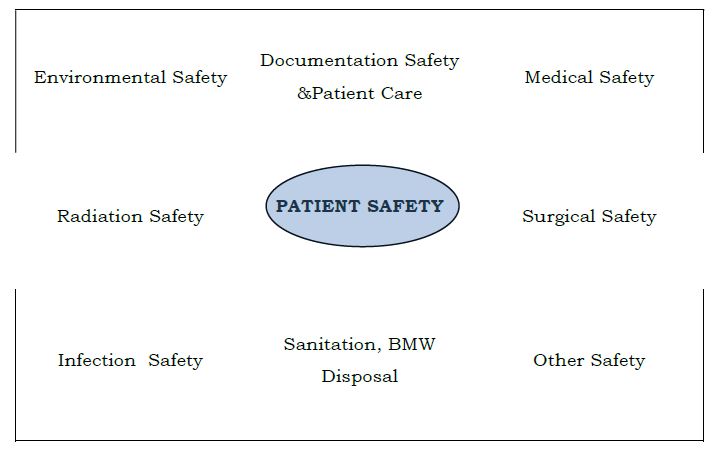Patient safety is our chief priority and as a dental institution we tend to learn from our patients, hence we treat them with prime importance. This manual discusses the patient safety precautions followed in our institution.
Our organization enhances patient safety by educating employees and professional staff about reliable risk prevention practices
PRINCIPLE OF PATIENT SAFETY
- Proper identification of patient and matching to their care elements
- Prevention of patient handover error and safety during transition
- Assessing medical accuracy while giving care to a patient
- Performance of correct procedure at correct body site
- Take appropriate precautionary measures to avoid infection
TYPES OF PATIENT SAFETY

ENVIORNMENTAL SAFETY
- Ensure a clutter-free, well lit environment
- Adequate ventilation, exhaust fan.
- Stairs with hand rails.
- Slip preventing floors
- Fire extinguishers.
- Prevent noise pollution.
- Safe wheel chairs and trolleys.
- No water logging in the bathrooms.
- Adequate number of bed screens to maintain privacy of the patient.
DOCUMENTATION SAFETY & PATIENT CARE
- Each patient is allotted a unique outpatient number that is kept confidentially between the patient and the college. Patient’s detail and treatment information is maintained through patient management software which is securely stored.
- Patients are identified by at least three patient identifiers including registration number in all the process of diagnosis and treatment.
- Patient is given detailed information on the treatment procedures to be performed.
- The dental hospital building has CCTV Surveillance in each floor.
- Drinking water facility is available.
- Elevator can be used by the patient that is operated by a trained lift operator, and is battery supported.
MEDICAL SAFETY
- Medication orders should be written legibly in ink and should include
- Patients name, age and sex
- Date and hour order was written.
- Medication generic name.
- Dosage, frequency and route of administration.
- Signature of the physician.
- Any abbreviations used in the medication orders should be agreed to and jointly adopted by the medical, nursing pharmacy, and medical records staff of the institution. Lately, in the interest of patient safety, “Do Not Abbreviate” is the new practice
- Before dispensing the drug the pharmacist must receive the doctor’s original order or a direct copy of the order (except in emergency situations).
- To check at least two patient identifiers before providing care, treatments or services. (Patient name and medical record number)
- Discourage Telephonic orders , Do not accept verbal order
- Any prefilled syringe of drug should be labelled.
- Drugs once reconstituted should be used within 24 hrs or as per manufacturer’s instructions.
- Monitor Adverse Drug Reactions (ADR) (self-reporting of ADR by the health professionals or even the patients should be encouraged)
RADIATION PROTECTION:
We follow the AERB guidelines for effective radiation protection such as:
- The layout of the Department is as per AERB norms.
- Radiographic Equipment are purchased from AERB certified companies.
- Qualified and trained personnel are employed.
- Personal maintaining services for radiation workers are ensured.
- Authorized representatives inspect the equipment and Periodic safety reports are submitted to AERB for certification.
- 9-inch wall is provided for the room and walls are coated with lead.
- Lead lined door and screen.
- Personnel use of lead apron, lead gloves and goggles is insisted for the Radiologist
- Thyroid collar is in use.
- Warnings are posted of radiation hazards for pregnant women.
- Warnings lights are in place.
SURGICAL SAFETY
- Consent of the patient/relative in writing
- Proper identification of patient
- Proper identification mark of parts to be operated
- Pre operative check up
- Anaesthetic safety
- Ensure no foreign body left inside
- Safety measures from ward to OT and coming back
- Prevention of surgical wound infection
- Use of surgical safety proforma in all operations
INFECTION CONTROL MEASURES:
- All diagnostic and treatment procedures are carried out with instruments that are properly sterilised with utmost care.
- Disinfection of floors, dental chairs are done on a daily basis to ensure protection against the spread of communicable diseases.
- Fumigation of operating theatre and closed clinical areas is done on a regular basis.
- Dental unit waterlines, bio-film, and water quality are checked periodically.
- Use of Disposable gloves, masks, and suction tips.
- Alcohol based hand rub is available in all floors.
BIO MEDICAL WASTE MANAGEMENT:
- Our institution follows stringent protocols for bio medical waste management as guided by the Andhra Pradesh Pollution Control Board and MoU exists between the Institute and an agency authorized by Andhra Pradesh Waste Management Board and its timely renewal is done.
- We take meticulous steps to ensure proper disposal of radioactive materials as directed by AERB.
COVID PROTOCOL:
- Use of personal protective equipment by the dental professionals while treating patients.
- Temperature screening done for patients, dental care providers and staffs.
- In accordance with state and CDC guidelines for healthcare settings, we are maintaining social distancing requirements in our clinical facility.